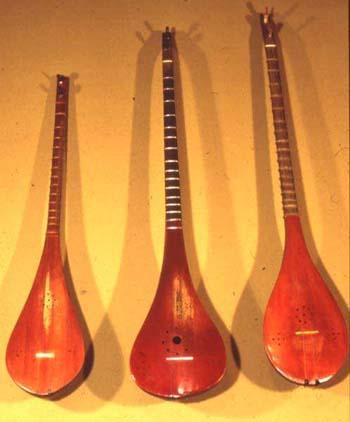Tanbur
The tanbur is another long-neck lute from Central Asia that exist in different shapes, and is the wire-strung companion of the dutar.
The body of the tanbur is made from a hollowed out piece of mulberry wood, and often smaller than the dutar. The front is made from mulberry.
The long neck (mulberry or apricot) is also the pegbox. The frets made of thick gut string are tied-on (3 windings) in some diatonic scale. At the left side of the neck is a groove to ease making the knots in the frets. There are 4 flat T-shaped friction pegs, two on the front, and two on the left. The 4 metal strings run over a small loose bridge to a bit of wood at the edge of the body. The first two strings are tuned the same, but they are so far apart that only the first one is fingered.
The neck is often highly decorated with inlay bone (or white plastic nowadays) in squares, triangles, lines. The top of the back has triangle inlays, together forming a kind of windrose. The soundholes are a few drilled holes in a geometrical design. The entire instrument is varnished.
The tanbur is always played with a wire plectrum on the index-finger, similar to the Indian sitar plectrum (mizrab), so you can pick forwards and backwards. The left hand plays mainly on the first course - the others are used as drones.
The music is usually instrumental, but the tanbur is also used to accompany singing.
Source: http://atlasofpluckedinstruments.com/central_asia.htm


